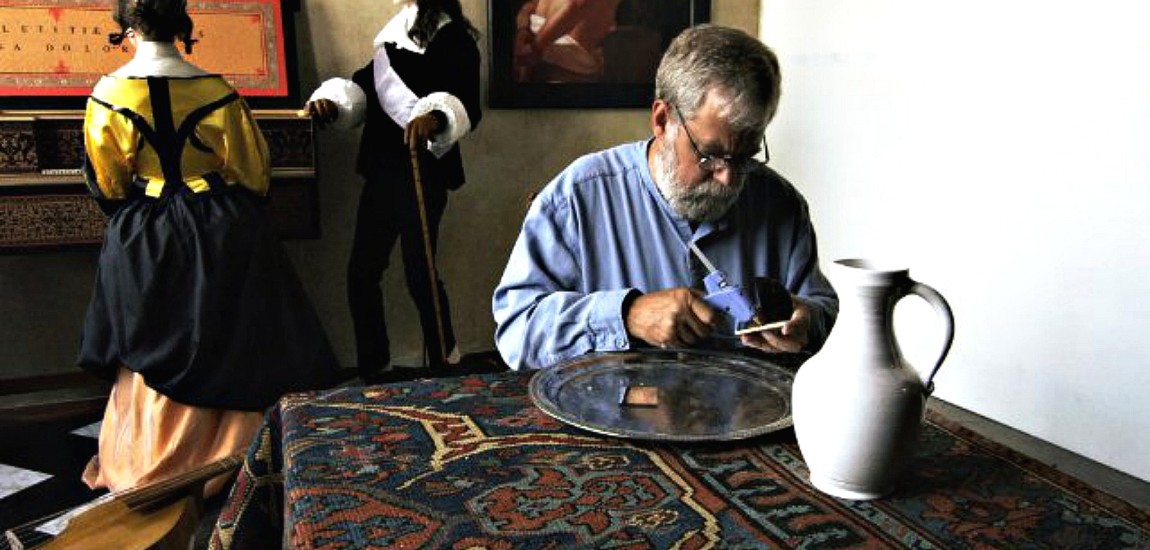Tim Paints Vermeer

by Michael Bergeron
The sign of a great film is one that means something different to everybody who watches. The documentary “Tim’s Vermeer” is just that. Directed by Teller (of the magic team Penn & Teller), “Tim’s Vermeer” chronicles how Tim Jenison, an inventor and software developer, deconstructed the process of painting a masterpiece using 17th century technology.
“My research started well before the movie, which started in February 2025. The movie was completed in August of 2025,” explained Tim, talking to Free Press Houston by phone from his home in San Antonio.
Tim was intrigued by the photorealistic qualities of the painting of Johannes Vermeer. Also of interest were books that postulated theories on how Vermeer used optics to paint – Philip Steadman’s “Vermeer’s Camera” and David Hockney’s “Secret Knowledge.” Both Steadman and Hockney appear in “Tim’s Vermeer.”
“Some people think that I was trying to copy a Vermeer,” said Tim. He was really trying to duplicate the methods Vermeer used for the painting “The Music Lesson.”
“I made a copy of the room that Vermeer used to paint. I got two models to come in and wear period clothes. One of them was my daughter. I got a hand on or built all the things you see in Vermeer’s painting, and then I set up the machine that Vermeer used, and used the machine to paint – not looking at the actual painting.” The machinery to which Tim refers included a lens used to project the image of the room along with a specifically curved mirror.
Perhaps the most amazing part of Tim’s project was how he reconstructed lenses and paints using materials and methods that would have been available in Vermeer’s time. For the lens, Tim went through a labor-intensive process. “It was very similar to a telescope lens that would’ve been used in Vermeer’s time, in all likelihood it was a telescope lens. Telescopes had been around in that time for 50 or 60 years. It was an extreme adoption of the technology, telescopes were all over the place.”
Using a lapidary wheel and a hunk of glass, Tim melted the glass into a plaster form to get the basic shape of the lens. “Then on a lathe you make a dish that has a gentle curve in it, like a section of a sphere, and the deepness of that dish determines how strong the lens will be,” Tim said. “I knew how strong that lens should be: it needed to project an image about 28 inches away. I knew that from the size of Vermeer’s painting.”
“You attach a wooden handle to the hunk of glass. And you start with a very coarse abrasive. They would’ve used sand then – I used modern abrasives. You put some water in it, and you move the glass back and forth into the dish. It takes off the high edges – it’s starting to look like a lens but it’s really frosty. You can’t see through it. Then you go to finer abrasives, and the lens becomes clearer and clearer. Hours and hours per step, six different grades of abrasive. The very last step is to polish it to a glass-like finish. Then they would’ve used something called diatomaceous earth, which is used in swimming pool filters. At that point, you use leather upon the dish so it’s no longer metal upon glass. And again you spend hours polishing it until it is crystal clear. I made six lenses that way. I wanted an imperfect lens. My lens ended up 4 inches in diameter with a focal length of 28 inches.”
Not quite as exacting but still demanding was Tim’s acquisition of pigments and oil. Vermeer used colors like lapis and ultramarine.
“There are companies that sell these ancient pigments. When they restore paintings they get tiny little chips that fall off, and they do analysis, and they can tell you what pigments were used. We know that Vermeer used a palette of 12 colors. I started with exactly the ones that he had,” said Tim. “The ultramarine blue, which is a ground gemstone, it’s quite expensive. It would’ve been worth more than its weight in gold in Vermeer’s time. I was able to buy the powdered version; I think it came from Chile. Then there are other pigments like the lead white and the lead tin yellow. The vermillion, which is a red color, is a compound of mercury. Most of the colors are pretty safe, they are just a combination of different colored dirt found in different parts of the Earth.”
“If you’re dealing with a powder it can be dangerous. You don’t want to inhale. I was able to get the dangerous colors premixed. The ultramarine I mixed a few times a week. It just does not store well. It hardens in the tube even without any air. I had to mix that constantly. All the other colors I would grind. So it was basically the lead white, the lead tin yellow and the vermillion that I bought with the oil mixed in,” said Tim.
“Tim’s Vermeer” is the kind of film that inspires people-inspires them to do what it is they do best. “Tim’s Vermeer” opens exclusively at the River Oaks Three on March 7.



